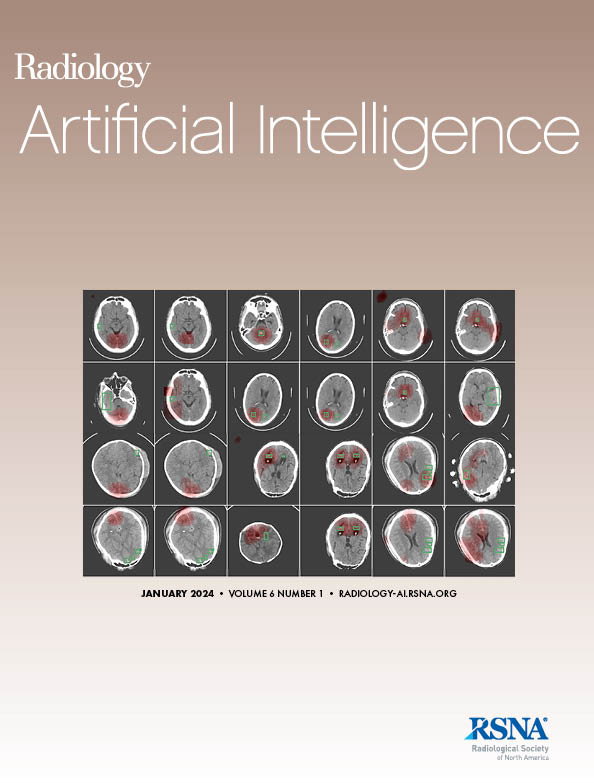Veit Sandfort, Martin J Willemink, Marina Codari, Domenico Mastrodicasa, Dominik Fleischmann
下载PDF
{"title":"Denoising Multiphase Functional Cardiac CT Angiography Using Deep Learning and Synthetic Data.","authors":"Veit Sandfort, Martin J Willemink, Marina Codari, Domenico Mastrodicasa, Dominik Fleischmann","doi":"10.1148/ryai.230153","DOIUrl":null,"url":null,"abstract":"<p><p>Coronary CT angiography is increasingly used for cardiac diagnosis. Dose modulation techniques can reduce radiation dose, but resulting functional images are noisy and challenging for functional analysis. This retrospective study describes and evaluates a deep learning method for denoising functional cardiac imaging, taking advantage of multiphase information in a three-dimensional convolutional neural network. Coronary CT angiograms (<i>n</i> = 566) were used to derive synthetic data for training. Deep learning-based image denoising was compared with unprocessed images and a standard noise reduction algorithm (block-matching and three-dimensional filtering [BM3D]). Noise and signal-to-noise ratio measurements, as well as expert evaluation of image quality, were performed. To validate the use of the denoised images for cardiac quantification, threshold-based segmentation was performed, and results were compared with manual measurements on unprocessed images. Deep learning-based denoised images showed significantly improved noise compared with standard denoising-based images (SD of left ventricular blood pool, 20.3 HU ± 42.5 [SD] vs 33.4 HU ± 39.8 for deep learning-based image denoising vs BM3D; <i>P</i> < .0001). Expert evaluations of image quality were significantly higher in deep learning-based denoised images compared with standard denoising. Semiautomatic left ventricular size measurements on deep learning-based denoised images showed excellent correlation with expert quantification on unprocessed images (intraclass correlation coefficient, 0.97). Deep learning-based denoising using a three-dimensional approach resulted in excellent denoising performance and facilitated valid automatic processing of cardiac functional imaging. <b>Keywords:</b> Cardiac CT Angiography, Deep Learning, Image Denoising <i>Supplemental material is available for this article.</i> © RSNA, 2024.</p>","PeriodicalId":29787,"journal":{"name":"Radiology-Artificial Intelligence","volume":" ","pages":"e230153"},"PeriodicalIF":8.1000,"publicationDate":"2024-03-01","publicationTypes":"Journal Article","fieldsOfStudy":null,"isOpenAccess":false,"openAccessPdf":"https://www.ncbi.nlm.nih.gov/pmc/articles/PMC10982910/pdf/","citationCount":"0","resultStr":null,"platform":"Semanticscholar","paperid":null,"PeriodicalName":"Radiology-Artificial Intelligence","FirstCategoryId":"1085","ListUrlMain":"https://doi.org/10.1148/ryai.230153","RegionNum":0,"RegionCategory":null,"ArticlePicture":[],"TitleCN":null,"AbstractTextCN":null,"PMCID":null,"EPubDate":"","PubModel":"","JCR":"Q1","JCRName":"COMPUTER SCIENCE, ARTIFICIAL INTELLIGENCE","Score":null,"Total":0}
引用次数: 0
引用
批量引用
Abstract
Coronary CT angiography is increasingly used for cardiac diagnosis. Dose modulation techniques can reduce radiation dose, but resulting functional images are noisy and challenging for functional analysis. This retrospective study describes and evaluates a deep learning method for denoising functional cardiac imaging, taking advantage of multiphase information in a three-dimensional convolutional neural network. Coronary CT angiograms (n = 566) were used to derive synthetic data for training. Deep learning-based image denoising was compared with unprocessed images and a standard noise reduction algorithm (block-matching and three-dimensional filtering [BM3D]). Noise and signal-to-noise ratio measurements, as well as expert evaluation of image quality, were performed. To validate the use of the denoised images for cardiac quantification, threshold-based segmentation was performed, and results were compared with manual measurements on unprocessed images. Deep learning-based denoised images showed significantly improved noise compared with standard denoising-based images (SD of left ventricular blood pool, 20.3 HU ± 42.5 [SD] vs 33.4 HU ± 39.8 for deep learning-based image denoising vs BM3D; P < .0001). Expert evaluations of image quality were significantly higher in deep learning-based denoised images compared with standard denoising. Semiautomatic left ventricular size measurements on deep learning-based denoised images showed excellent correlation with expert quantification on unprocessed images (intraclass correlation coefficient, 0.97). Deep learning-based denoising using a three-dimensional approach resulted in excellent denoising performance and facilitated valid automatic processing of cardiac functional imaging. Keywords: Cardiac CT Angiography, Deep Learning, Image Denoising Supplemental material is available for this article. © RSNA, 2024.
利用深度学习和合成数据对多相功能性心脏 CT 血管造影进行去噪。
"刚刚接受 "的论文经过同行评审,已被接受在《放射学》上发表:人工智能》上发表。这篇文章在以最终版本发表之前,还将经过校对、排版和校对审核。请注意,在制作最终校对稿的过程中,可能会发现影响内容的错误。冠状动脉 CT 血管造影 (CTA) 越来越多地用于心脏诊断。剂量调制技术可减少辐射剂量,但产生的功能图像噪声大,对功能分析具有挑战性。这项回顾性研究介绍并评估了一种用于心脏功能成像去噪的深度学习方法,该方法利用了三维卷积神经网络中的多相信息。冠状动脉 CT 血管造影(n = 566)用于生成合成数据进行训练。基于深度学习的图像去噪(DLID)与未经处理的图像和标准降噪算法(BM3D)进行了比较。对图像质量进行了噪声和信噪比测量以及专家评估。为了验证去噪图像是否可用于心脏量化,进行了基于阈值的分割,并将结果与未处理图像的人工测量结果进行了比较。与基于标准去噪的图像相比,基于深度学习的去噪图像明显改善了噪声(左心室血池的 SD 值为 20.3 ± 42.5 HU,DLID 为 33.4 ± 39.8 HU,BM3D 为 33.4 ± 39.8 HU,P < .0001)。与标准去噪相比,专家对基于深度学习的去噪图像质量的评价明显更高。基于深度学习的去噪图像上的半自动左心室尺寸测量结果与未处理图像上的专家量化结果显示出极好的相关性(类内相关系数为 0.97)。基于深度学习的三维去噪方法具有出色的去噪性能,有助于对心脏功能成像进行有效的自动处理。©RSNA,2024。
本文章由计算机程序翻译,如有差异,请以英文原文为准。

 求助内容:
求助内容: 应助结果提醒方式:
应助结果提醒方式:


